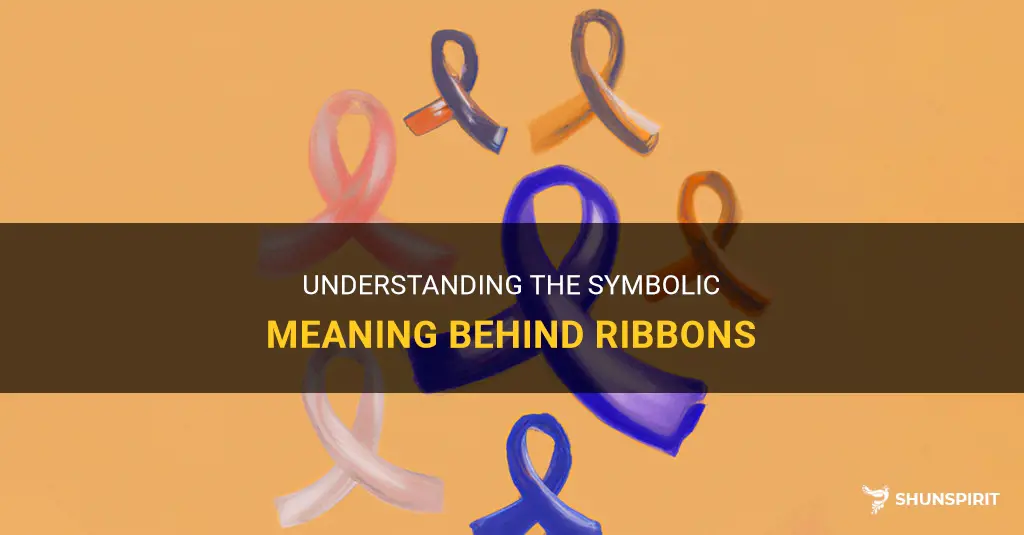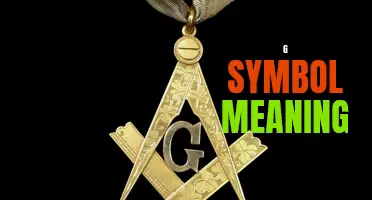
Ribbon symbols have been used throughout history to convey meaning and represent various causes, emotions, and movements. From the iconic pink ribbon symbolizing breast cancer awareness to the yellow ribbon symbolizing support for our troops, these small but powerful emblems bring people together and raise awareness on a global scale. Each color and design carries its own significance, creating a visual language that speaks volumes without the need for words. So, let's unravel the meaning behind these ribbon symbols and discover the stories they tell.
What You'll Learn
- What does the ribbon symbol typically represent?
- Are there different colors of ribbon symbols and do they have different meanings?
- How did the ribbon symbol become associated with specific causes or awareness campaigns?
- Do ribbon symbols have any cultural or historical significance?
- Are there any alternative symbols or icons that are used in place of or alongside ribbon symbols?

What does the ribbon symbol typically represent?
The ribbon symbol is commonly associated with various meanings and causes. It is often used to raise awareness and show support for certain causes or conditions. The ribbon symbol comes in many different colors, with each color representing a specific cause or issue. The use of ribbons as a symbol started in the early 1990s and has since become a powerful visual representation.
The ribbon symbol gained popularity as a way to publicly demonstrate support for important causes. It allows individuals to express their solidarity with a cause or issue in a simple yet impactful way. By wearing or displaying a ribbon, people can spark conversations and raise awareness about various causes.
Some of the most well-known ribbon colors and their associated causes are:
- Pink ribbon: The pink ribbon is widely recognized as the symbol of breast cancer awareness. It represents support for breast cancer patients, survivors, and raising awareness about the disease.
- Red ribbon: The red ribbon is a symbol for a range of causes, including HIV/AIDS awareness, heart disease awareness, and substance abuse prevention.
- Yellow ribbon: The yellow ribbon is often used to symbolize support for military personnel, prisoners of war (POW), and those missing in action (MIA). It is also associated with suicide prevention awareness.
- Blue ribbon: The blue ribbon is commonly used to raise awareness for child abuse prevention, prostate cancer, and colorectal cancer.
- Purple ribbon: The purple ribbon represents a variety of causes, including Alzheimer's disease awareness, epilepsy awareness, domestic violence awareness, and pancreatic cancer.
- Green ribbon: The green ribbon is often associated with mental health awareness, organ transplant awareness, and environmental causes.
- Orange ribbon: The orange ribbon symbolizes multiple causes such as leukemia awareness, multiple sclerosis, and self-harm awareness.
The ribbon symbol is not limited to these colors and causes; each year new ribbon colors and meanings are added to raise awareness for different issues. For example, the teal ribbon is now commonly associated with ovarian cancer awareness.
Wearing or displaying a ribbon shows support and solidarity, but it is also important to educate oneself and take action beyond a symbolic gesture. Engaging in activities such as fundraising, volunteering, and advocating for change can have a more significant impact in addressing the issues represented by the ribbon symbol. By combining awareness with action, individuals can contribute to making a difference in their communities and beyond.
Decoding the Hidden Meanings Behind Hollywood's Most Iconic Symbols
You may want to see also

Are there different colors of ribbon symbols and do they have different meanings?
Ribbon symbols have been used for centuries to represent various causes, movements, and awareness campaigns. These symbols are often displayed on ribbons of different colors to represent different causes. While the colors of ribbon symbols can vary, they do have different meanings associated with them.
One of the most well-known ribbon symbols is the pink ribbon, which is used to raise awareness for breast cancer. The pink ribbon is often worn during Breast Cancer Awareness Month in October and represents support for breast cancer survivors and those currently fighting the disease.
Another commonly recognized ribbon symbol is the red ribbon, which is used to raise awareness for HIV/AIDS. The red ribbon is often worn on World AIDS Day, observed on December 1st, to show solidarity with those affected by the disease and to promote education and prevention efforts.
There are many other colors of ribbon symbols, each representing a different cause or movement. For example:
- Yellow ribbons are often used to support military troops and show solidarity with those serving in the armed forces.
- Purple ribbons are associated with a variety of causes, including Alzheimer's disease, pancreatic cancer, and domestic violence awareness.
- Blue ribbons are used to raise awareness for various causes, such as child abuse prevention, men's health, and colon cancer.
- Green ribbons are often used to promote mental health awareness and support individuals with conditions such as depression, anxiety, and bipolar disorder.
- Orange ribbons are associated with multiple causes, including leukemia awareness, self-harm prevention, and kidney cancer.
It's important to note that the meanings of ribbon symbols can vary depending on the context and organization using them. While certain colors may have established meanings, individual organizations may assign different meanings to specific colors to represent their cause or campaign. Additionally, new ribbon symbols and colors are continuously being introduced as new causes and awareness campaigns emerge.
In conclusion, ribbon symbols come in various colors and each color has a different meaning associated with it. Whether it's the pink ribbon for breast cancer awareness or the red ribbon for HIV/AIDS awareness, these symbols play an important role in raising awareness and showing support for various causes and movements.
The Meaning Behind the Eye With Lashes Symbol: Exploring Its Origins and Symbolism
You may want to see also

How did the ribbon symbol become associated with specific causes or awareness campaigns?
The ribbon has become a powerful and recognizable symbol for different causes and awareness campaigns. Its origins can be traced back to the yellow ribbons that were tied around trees during the American Civil War to show support for soldiers fighting on the front lines. However, it was in 1979 that the use of ribbons as a symbol for causes really took off.
In that year, a group of American hostages were taken in Iran, and Penney Laingen, the wife of one of the hostages, tied a yellow ribbon around an oak tree in her front yard as a symbol of hope and support for her husband and the other hostages. This act captured the attention of the media and soon, yellow ribbons began to appear all over the country as a way for people to show solidarity and support for the hostages.
The success of the yellow ribbon campaign inspired others to use ribbons as symbols for different causes. In the 1980s, the red ribbon became associated with the fight against AIDS. This was a time when the disease was highly stigmatized and misunderstood, and the red ribbon was a way for people to show compassion and support for those affected by HIV/AIDS.
Since then, the ribbon has been used to raise awareness for countless other causes and issues. Pink ribbons are associated with breast cancer awareness, while green ribbons are used to raise awareness about mental health. Different colors have been assigned to different causes as a way to easily identify and represent them.
The ribbon symbol is so effective because it is simple, easily recognizable, and can be worn or displayed in a variety of ways. From lapel pins to car magnets, ribbons have become a popular accessory for people looking to show their support for a cause.
In addition to their visual appeal, ribbons also carry a symbolic meaning. They signify unity, support, and solidarity. By wearing a ribbon, a person is saying "I am aware of this issue, and I care." The ribbon serves as a conversation starter and a way to spread awareness and educate others about important causes.
The ribbon symbol has become so ingrained in popular culture that its meaning is almost universally understood. When people see a ribbon, they know that it represents a specific cause or issue. This broad recognition has helped to spread awareness and generate support for countless causes and campaigns.
In conclusion, the ribbon symbol has become associated with specific causes and awareness campaigns through the power of symbolism, media attention, and social solidarity. Its simple and recognizable design has made it an effective tool for raising awareness and showing support for a variety of issues. Whether it's a yellow ribbon for hostages, a red ribbon for AIDS, or a pink ribbon for breast cancer, the ribbon symbol continues to be a powerful way for individuals to make a statement and show their support for important causes.
Decoding the Symbolism and Meaning Behind Pineapples
You may want to see also

Do ribbon symbols have any cultural or historical significance?
Ribbon symbols have been used by various cultures throughout history and carry different meanings depending on the context and culture. These symbols are often associated with important events, achievements, or causes. Let's explore the cultural and historical significance of ribbon symbols.
In ancient Greece, a red ribbon known as the "kredemnon" was worn by military officers to signify their bravery and valor in battle. This tradition later influenced the use of ribbons as military decorations in modern times. Ribbons were also used to adorn clothing and accessories in ancient Rome as a symbol of wealth and status.
In the Middle Ages, ribbons gained religious significance. The Catholic Church used ribbons to symbolize different liturgical seasons. For example, purple ribbons were used during Lent to represent repentance and preparation for Easter. Ribbons were also used to attach charms and relics to religious objects such as rosaries, further emphasizing their spiritual importance.
During the Renaissance, ribbons became popular accessories in Europe for both men and women. They were used to decorate clothing, hats, and footwear, with each color symbolizing different emotions or societal status. For instance, a red ribbon was often associated with love and passion, while a black ribbon was worn to signify mourning.
In the 18th and 19th centuries, ribbons became widely used as symbols of political and social causes. The yellow ribbon, for example, was worn by women waiting for their loved ones to return from war. This tradition evolved into the modern symbol of support for military personnel and prisoners of war. Ribbons also played a significant role in the suffrage movement, with purple, white, and green ribbons symbolizing loyalty, purity, and hope, respectively.
Additionally, ribbons have been used to raise awareness for various diseases and medical conditions. The pink ribbon, for instance, represents breast cancer awareness, while the red ribbon is commonly associated with HIV/AIDS awareness. These ribbons serve as a visual reminder of the importance of education, support, and fundraising for their respective causes.
In recent years, ribbon symbolism has expanded beyond physical ribbons to include virtual ribbons on social media platforms. The trend of overlaying a ribbon image on profile pictures has become a popular way to show support for different causes and movements.
In conclusion, ribbon symbols have a rich cultural and historical significance. They have been used by various cultures over time to represent bravery, religious devotion, social causes, and medical awareness. Ribbons continue to be a powerful visual tool for raising awareness, showing support, and symbolizing important causes in our society.
Unlocking the Meaning Behind Various Symbols
You may want to see also

Are there any alternative symbols or icons that are used in place of or alongside ribbon symbols?
Ribbon symbols are commonly used to represent various causes, events, or awareness campaigns. However, there are instances where alternative symbols or icons are used in place of or alongside ribbon symbols. These alternative symbols may also carry significant meanings and help raise awareness for specific causes. Here are some examples:
- Puzzle Pieces: Puzzle piece symbols are often used to represent autism awareness. This symbolizes the complexity of autism and the diversity of individuals with autism spectrum disorder.
- Yellow Ribbon: In addition to the well-known pink ribbon symbol for breast cancer awareness, a yellow ribbon is sometimes used to raise awareness for various other causes, such as supporting U.S. troops, suicide prevention, and bladder cancer awareness.
- Red Dress: The Red Dress symbol is used to raise awareness about heart disease in women. It represents the efforts to change stereotypes and remind women to prioritize their heart health.
- Teal Ribbon: The teal ribbon symbolizes support and awareness for ovarian cancer. It is often used in campaigns promoting early detection and research funding for this type of cancer.
- Purple Ribbon: The purple ribbon is commonly associated with awareness for Alzheimer's disease. It represents the ongoing efforts to find a cure and support individuals and families affected by this condition.
- Pink and Blue Ribbons: The pink and blue ribbon symbolizes pregnancy and infant loss awareness. It is used to create a supportive environment for families who have experienced the loss of a baby during pregnancy or shortly after birth.
- Orange Ribbon: The orange ribbon is often used to raise awareness for multiple sclerosis. It represents the ongoing efforts to find a cure for this chronic illness and support individuals living with MS.
- Green Ribbon: The green ribbon symbolizes mental health awareness. It is used to reduce stigma and support individuals struggling with mental health conditions.
These alternative symbols or icons provide visual recognition for various causes and amplify their visibility. They help start conversations, create support networks, and raise funds for research, treatment, and support services. While ribbon symbols are widely recognized, alternative symbols and icons offer unique ways to represent specific causes and engage communities in meaningful discussions surrounding these issues.
The Meaning and Significance of the Atom Symbol
You may want to see also
Frequently asked questions
The ribbon symbol is often used to represent awareness and support for a particular cause or issue. Each color of ribbon is associated with a specific cause, such as pink for breast cancer awareness or red for AIDS awareness.
The ribbon symbol gained popularity in the 1990s as a way to raise awareness and show support for various causes. It was heavily featured in campaigns and events, and quickly became recognized as a symbol of solidarity and advocacy.
Yes, the ribbon symbol can have multiple meanings depending on the context. For example, a yellow ribbon can symbolize support for military troops or awareness for suicide prevention. It is important to consider the specific color and cause associated with the ribbon symbol to fully understand its meaning.
There are various ways to show support using the ribbon symbol. You can wear a ribbon pin or badge on your clothing, display a ribbon magnet on your car, or use the ribbon symbol in your social media profile picture. Additionally, participating in events or campaigns related to the cause can also show your support.







